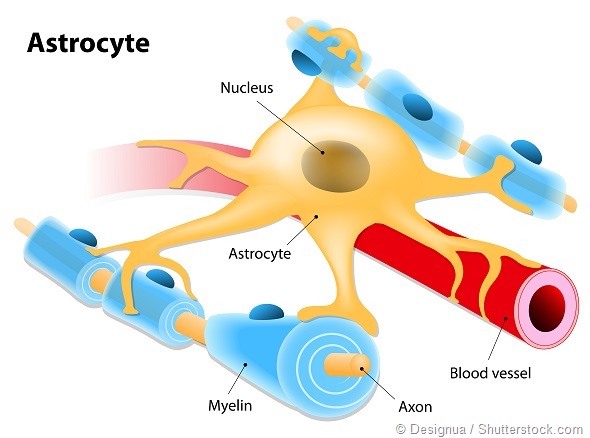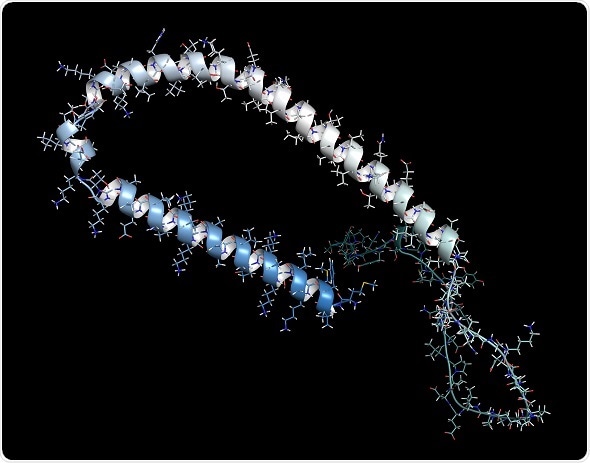What potential does gene silencing hold for tackling neurological conditions?
Many gene mutations that cause neurological disorders have been identified. For example, in a rare neurological disorder such as Huntington’s disease, an autosomal dominant mutation through expansion of CAG (cytosine-adenine-guanine) triplet repeats in the gene coding for the Huntingtin protein results in abnormal protein production.
This in turn promotes nuclear inclusions and toxic aggregates that lead to neurodegeneration and cell death in highly sensitive GABA medium spiny neurons in the striatum and motor cortex neurons.
In other neurological disorders such as Parkinson’s disease, there is evidence that locus triplication produces ~two-fold increase in alpha-synuclein protein expression that leads to an early onset Parkinson’s disease with Lewy Body formation in substantia nigra compacta and locus coeruleus.
Reduction in or “normalization” of “mutant” protein levels through gene silencing approaches such as antisense or siRNA in selected neurons involved in the disease process have shown cell survival and functional improvements in several disease animal models and hold the therapeutic potential of for use in patients to restore the neurotransmission and stop the disease progression.
Why has progress been limited so far? What barriers need to be overcome?
One of the major challenges to gene silencing approaches using antisense or siRNA oligonucleotides has been to get them effectively inside the cell.
Furthermore, it would be desirable to selectively target only the cell populations of interest (i.e. those involved in the disease) without indiscriminately targeting all cells resulting in a narrow therapeutic margin.
Finally, the additional barrier for the treatment of neurological diseases has been to get the therapeutic (be it an antibody or oligonucleotide) effectively across the blood-brain-barrier since the cells affected in neurological diseases are within the central nervous system.

How has CRISPR/CAS 9 impacted the field?
The CRISPR/CAS 9 technology has the potential to revolutionize medicine by “editing” disease-associated genes with a single treatment. The therapeutic applications of the technology are being rapidly developed and the early applications use viral vectors or lipid nanoparticles for delivery of the “CRISPR/CAS 9 therapeutic”.
The first applications of the technology have utilized ex vivo models like CAR-T receptor “tuning” against tumors by using the patient’s own lymphocytes which may be re-infused.
Other applications may include direct local injection to the eye for treatment of retinal diseases. Targeting the liver or the muscle through systemic administration has shown some initial positive data in animal models and gives hope to the field.
To the best of our knowledge, the applications to neurological disorders have not been explored in part because of the limitations of viral delivery to neurons or some of the challenges identified above for gene silencing applications.
Can you please outline nLife’s work on a technology to target brain neurons involved in disease processes?
The goal of nLife’s lead program is to “normalize” the elevated levels of alpha-synuclein in selected brain neurons seen in Parkinson’s disease in order to restore the neurotransmission and stop progression of the disease.
nLife’s approach is to selectively deliver to dopamine, serotonin and norepinephrine producing neurons in the brain an antisense oligonucleotide targeting alpha-synuclein by linking the 18-base oligonucleotide GapMer (complementary sequence to alpha-synuclein) to a small molecule (indatraline) which has high affinity for dopamine, serotonin and norepineprhine transporters.
By reducing alpha-synuclein in dopamine neurons, the Company hopes to treat the dopamine-related motor symptoms associated with Parkinson’s disease, while targeting alpha-synuclein in serotonin and norepinephrine neurons may ameliorate the non-motor (depression, anxiety, sleep disturbances etc.) symptoms associated with the disease.
A second generation program is evaluating a complementary gene silencing approach using a novel siRNA chemistry targeting alpha-synuclein with potential for less frequent dosing.
The second program is targeting the Huntingtin gene involved in Huntington’s disease with the goal of reducing the Huntingtin protein thereby slowing down the disease progression and allowing for recovery of the “fine motor” capabilities.
For the treatment of Huntington’s disease, nLife’s approach is to selectively deliver an antisense oligonucleotide targeting Huntingtin linked to a small molecule targeting receptors localized in brain areas such as the basal ganglia (striatum) and cerebral cortex which are primarily affected in Huntington’s disease.

© molekuul.be / Shutterstock.com
What stage of development is this technology at?
The lead antisense oligonucleotide targeting alpha-synuclein in combination with indatraline (NLF-PD-1233) has been validated in cellular, rodent and non-human primate models.
In aged Rhesus monkeys, following chronic infusion directly into the cerebral ventricles, there is ~40% decrease in alpha-synuclein in brain areas affected in the disease such as the substantia nigra dopamine cells while other brain areas not involved in the disease process such as the hippocampus are unaffected.
Furthermore, it has been demonstrated in both rodent and non-human primate models that NLF-PD-1233 gets into the brain following intranasal administration and decreases alpha-synuclein levels demonstrating the future potential for a more non-invasive treatment paradigm.
What further research is needed?
nLife is currently planning an additional study in non-human primates (using an Ommaya reservoir for delivery of NLF-PD-1233 directly into the brain lateral ventricles, similar to what will be used in the initial human trials in patients) to further validate the treatment paradigm and to develop biomarkers and imaging markers that could be used in early clinical trials to monitor effectiveness of the therapy.
This will be followed by the requisite regulatory toxicology studies in non-human primates in 2017 for potential initiation of human studies which are projected for 2018.
The program for the treatment of Huntington’s disease is at a much earlier stage of discovery and will follow a similar path to that used for the identification of NLF-PD-1233.
Finally, from a platform development standpoint, nLife has validated the gene silencing approach for several combinations of genes of interest and small molecule ligands targeting entry into different areas of the brain, spinal cord or muscle. Ongoing work (albeit at a much earlier stage) is focused on expanding the platform for application to non-viral CRISPR/CAS 9 and mRNA delivery using the Company’s proprietary small molecule linker technology.
How important do you think gene silencing will be in the future of therapeutics for neurological conditions?
More and more genes associated or contributing to various neurological diseases are constantly being identified and represent some of the most promising targets for the treatment of these diseases.
Unfortunately, small molecule therapeutics which are often used for symptomatic treatment of many of these neurological and psychiatric disorders are not easily amenable to disruption of the protein-protein interactions.
Gene silencing and hopefully gene editing approaches in the future coupled with nLife’s proprietary technology to develop oligonucleotide therapeutics linked to small molecules to facilitate entry into specific neurons, cells and/or circuits involved in the disease process pave the way for one of the best ways to target genes of interest in the brain for treatment of these devastating disease processes.
What is nLife’s vision for the future?
nLife’s vision is to be the premier company developing proprietary enabling targeting platform technologies for delivery of active nucleic acid based therapeutics to specific cell populations for the treatment of neurological & neuromuscular disorders.
The Company’s near term pipeline includes development of therapeutics in market opportunities for genetically validated targets in both large (Parkinson’s disease) and premium-priced orphan (Huntington’s disease) neurological diseases.
The platform has been validated in animal models to explore the potential of precision medicine therapeutics utilizing “gene silencing” approaches such as antisense and siRNA and is being expanded to the exciting emerging applications of “nonviral CRISPR/CAS9 gene therapy” for treatment of a broad array of genetic disorders.
The Company is implementing a balanced business strategy for internal pipeline and platform development and external validation through collaborations and partnerships to generate short term non-dilutive funding and access to proprietary oligonucleotide technology.
Where can readers find more information?
Website: https://www.n-life.es/
Publications:
- Ferrés-Coy, A., Galofré, M., Pilar-Cuellar, F., Vidal, R., Paz, V., Ruiz-Bronchal, E., et al. (2015). Therapeutic antidepressant potential of a conjugated siRNA silencing the serotonin transporter after intranasal administration. Molecular Psychiatry. http://doi.org/10.1038/mp.2015.80
- Ferrés-Coy, A., Santana, N., Castañé, A., Cortés, R., Carmona, M. C., Toth, M., et al. (2013). Acute 5-HT(1A) autoreceptor knockdown increases antidepressant responses and serotonin release in stressful conditions. Psychopharmacology, 225(1), 61–74. http://doi.org/10.1007/s00213-012-2795-9
About Errol de Souza
Dr De Souza is a leader in the development of therapeutics for treatment of central nervous system (CNS) disorders.
He is currently Executive Chairman of nLife Therapeutics and is the former President and CEO of US biotech companies Biodel Inc. (NASDAQ:BIOD), Archemix Corporation and Synaptic Pharmaceutical Corporation (NASDAQ:SNAP).
Dr De Souza formerly held senior management positions at Aventis and its predecessor Hoechst Marion Roussel Pharmaceuticals, Inc.
Most recently, he was Senior Vice President and Site Head of US Drug Innovation and Approval (R&D), at Aventis, where he was responsible for the discovery and development of drug candidates through Phase IIa clinical trials for CNS and inflammatory disorders.
Prior to Aventis, he was a co-founder and Chief Scientific Officer of Neurocrine Biosciences (NASDAQ:NBIX). Dr De Souza has served on multiple editorial boards, National Institutes of Health (NIH) Committees and is currently a Director of several public and private companies.
Dr. De Souza received his B.A. (Honors) in physiology and his Ph.D. in neuroendocrinology from the University of Toronto and he received his postdoctoral fellowship in neuroscience from The Johns Hopkins University School of Medicine.
He has edited 6 books and is an author or co-author of approximately 290 original articles, chapters or reviews and 300 abstracts. His research has focused on the receptor mechanisms involved in coordinating brain-endocrine-immune responses to stress.
He is the recipient of numerous national and international awards including the 1990 Joseph Cochin Young Investigator Award of the Committee on Problems of Drug Dependence, the 1991 Jordi Folch-Pi Memorial Award of the American Society for Neurochemistry, the 1994 Curt Richter Award and the 2005 Service Award of the International Society of Psychoneuroendocrinology, the 1997 Daniel H. Efron Award of the American College of Neuropsychopharmacology and the 2005 Ernst & Young Entrepreneur of the Year (New England Biotech category).